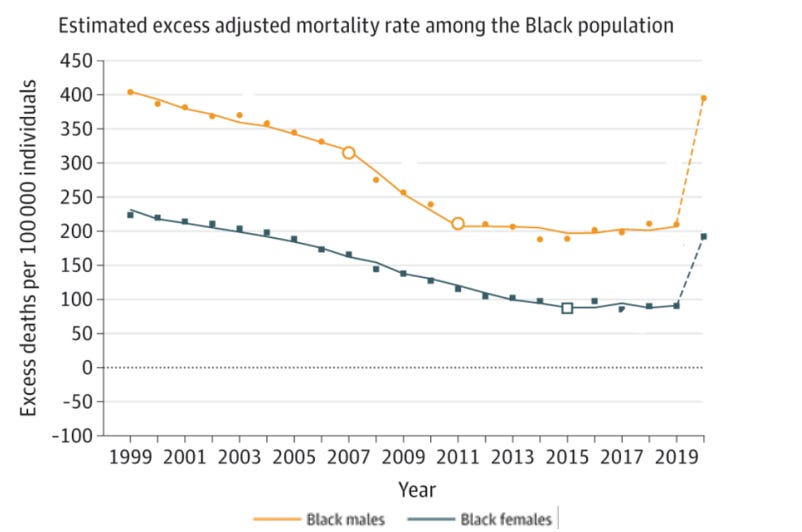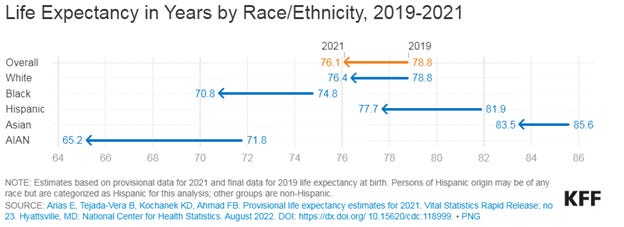Happy Friday!
Instead of a long note on Friday, this week I’ll spread my posts through the week. Please let me know whether you’d rather this newsletter as one long note or 3-4 shorter notes.
Today, I’ll review landmark research documenting excess mortality of Black people in the United States - and the economic cost of these excess deaths. Next week, look for randomized trials of artificial intelligence in health care, news about anti-obesity drugs, and some projections from the Congressional Budget Office on the impact of Medicaid disenrollments on employer-sponsored health plans.
Black people in the United States die earlier than white people, and the problem is getting worse
The Journal of the American Medical Association published a giant national study of death certificates from 1999-2020 and found that non-Hispanic Black men and women die at rates substantially higher than White people. The difference in life expectancy for Black males decreased by almost half from 1999-2011 but started increasing even before the pandemic. The disparity is now back to the level of 2000.
During this 21-year period, there were 1.63 million excess deaths among Black people, representing more than 80 million years of potential life lost.
Source: Caballero, et al JAMA May 16, 2023 LINK
Excess deaths from heart disease and cancer were large components of total excess mortality.
A separate study published in that issue of JAMA quantified the economic burden of health inequities for racial and ethnic minorities (including American Indian and Alaska Native, Asian, Black, Latino, and Native Hawaiian and Other Pacific Islander populations) was $421-$451 billion in 2018.
This week, KFF (formerly Kaiser Family Foundation) published data on the impact of the pandemic on life expectancy by race which shows similar results. There was a decrease in life expectancy at birth across all races - this was greater for Black people (loss of 4 years) than white people (loss of 2.4 years).
Source: Hill, et al KFF May 23, 2023 LINK
These data points can sometimes leave us numb. We must remember that disparities in life expectancy are deeply personal tragedies that affect entire families and communities.
Implications for employers:
- While many of the reasons for disparities require broad society interventions, employers can play a substantial role in decreasing premature mortality from heart disease (through better control of high blood pressure and cholesterol) and from cancer (through better screening and appropriate treatment). Employers can encourage carriers to improve provider access and increase diversity of providers, and to offer programs to help patients find providers who are a good match. Virtual care can increase the diversity of the pool of providers from which members can choose.
- Increased premature mortality means a smaller labor force, and increased costs to replace workers who die earlier than would otherwise be expected.
- Employers can demand that quality reporting be segmented by race and ethnicity to draw attention to disparities and expect carriers to develop plans to address these disparities. Here’s a good example of how one health plan, Blue Cross Blue Shield of Massachusetts, is doing this type of reporting.
Thanks for reading! Please subscribe, like, and share with colleagues! Have a great Memorial Day weekend.
Jeff




